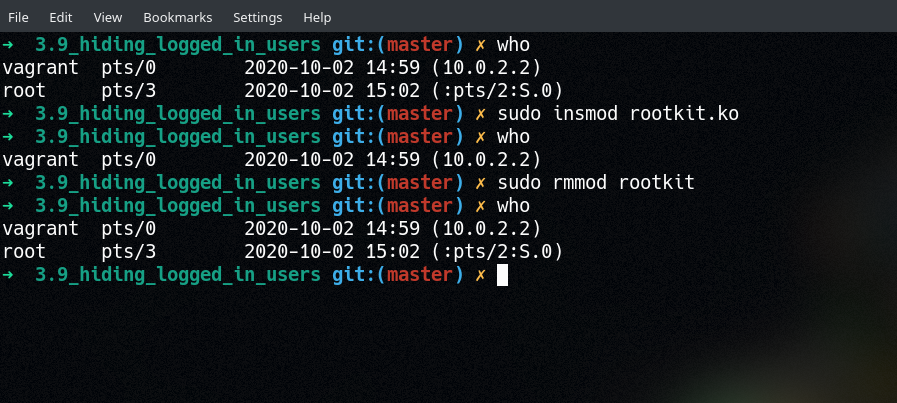
 GitBucket
GitBucket
| .. | |||
| Makefile | 5 years ago | ||
| README.md | 5 years ago | ||
| enum_utmp.c | 5 years ago | ||
| ftrace_helper.h | 3 years ago | ||
| hiding_logged_in_users.png | 5 years ago | ||
| rootkit.c | 4 years ago | ||
| utmp.h | 4 years ago | ||
Linux Kernel Hacking
3.9: Hiding Logged On Users
A blog post is now up with much more detail on how this work! Check it out here!
In order to discover active user sessions, most userspace programs read the contents of /var/run/utmp (if you know of a program that does it another way, please let me know!). This is a binary file filled with utmp structs (see man utmp, or utmp.h). By parsing this file, we can hide entries from userspace for which the ut_user field matches a pre-set value (in this case, root, but could be anything).
This works by hooking sys_openat() and checking each attempt to open a file for /var/run/utmp. If we get a match, we save the file descriptor in a global variable (tamper_fd). We also hook sys_pread64(), which is the syscall used by programs like who and finger to read the contents of binary files (like /var/run/utmp). In this hook, we wait for a file descriptor match with tamper_fd, and then check the ut_user field of each struct that gets read. If we find a match, then we fill the entry with 0x0 (in memory, the actual file on disk is never touched!). When the userspace program gets this empty buffer, it simply skips it and moves on the next one.
Also included in this directory is a program called enum_utmp. This program will read, parse and print the contents of /var/run/utmp more verbosely than who or finger will. In particular, it reads the entire contents of /var/run/utmp all at once, rather than line-by-line (which would be the "normal" way to do it). This means that we can loop through the entries ourselves manually and discover that root really is logged in, even when who and finger tell us it isn't.
To use:
- Build with
make - Load with
insmod rootkit.ko - In another terminal, spawn a root shell via
sudo screen -S root_login - Back in the non-root user's terminal, run
whoorfingerand confirm thatrootdoes NOT appear in the list - Unload the module with
rmmod rootkit - Run
whoorfingeragain and observe thatrootnow shows up!

(In the above screenshot, I have sudo screen -S root_login running in a separate window)